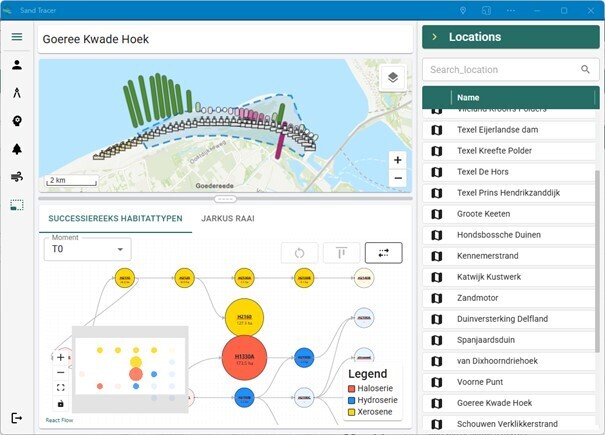J.K. Leenders1,2, C. Wegman1, M.Hoek1, K. van den Berg1, B. Arens3 , C. Aggenbach4
1HKV lijn in water, Netherlands; 2Hogeschool van Amsterdam, Netherlands; 3Arens, Bureau voor strand en Duinonderzoek, Netherlands; 3KWR, Water Research Institute, Netherlands
* Corresponding author: leenders@hkv.nl
Introduction
Dune nature is under pressure. Coastal erosion, rising sea levels, nitrogen deposition, acidification, overgrowth, increasing recreation and land use by other functions are placing increasing pressure on the dune landscape. Due to sea level rise, dune areas will be under even more pressure in the future. . This is especially the case in relatively narrow dune areas. Where dunes are narrow, large-scale dynamics are not an option, due to risks for coastal defense and functions in the area close to the sea.
Can seaward strategies provide solutions? A seaward extension provides safety for the area behind it. In addition, space is created for new dune nature. It may also contribute to increasing the freshwater supply.
In this OBN-project (Ontwikkeling+Beheer Natuurkwaliteit) insight is provided to assess the effects of options for seaward coastal expansion on the ecology of the dune nature.
Objective and Methods
The objective of the project is to develop guidelines for seaward coastal defence solutions that can be used to optimally develop dune nature and/or to halt the decline of dune nature in the current dune area. The methods that are used to meet this objective consist of a mix of review of literature, analysis of existing spatial data, field research and discussion of the findings with stakeholders and colleagues.
Time and spatial scales are important for strengthening coastal dunes, dune nature and the freshwater supply. Aeolian structures larger than embryo dunes can only form with a coastal extension of some size and the process of dune formation takes time (decades).
The existing seaward extensions in the Netherlands are mostly young, usually less than 20 years old.
Several examples have already been implemented in the Netherlands of both permanent solutions, which vary from small to large-scale, and temporary solutions. In some cases, these examples do not, strictly speaking, concern expansion of the coast, but they do contribute to the expansion of the dune area. In our approach we assume these systems develop in a similar manner as meganourishments.
Results
Developing dune ecosystems requires sufficient space and time. Pioneer communities can emerge quickly (0 years to the first decades), but the development of later successional stages that are also important for biodiverse dunes require more time (> four decades) due to the time required for soil succession and establishment of plant and animal species. This means that seaward expansions only contribute to high-quality dune nature if they have a certain spatial scale and have a sufficiently long survival time. As the formation of a freshwater bubble in a new dune area and the enlargement of the freshwater bubble in the existing dunes requires a minimum extent and a long development time (approximately 1 century).
This research will be finalisedmid-2025 and will result in:
- An overview of existing seaward solutions and natural references with their current natural values and development over time;
- Guidelines for new mega nourishments and other seaward solutions for optimal development of new and existing nature;
- Insight into which goals can be achieved with mega nourishments and which goals are difficult to achieve
- a viewer in which the data that was gathered for each study area is clearly presented (Figure)

Screenhot of viewer in which data on geomorphological development and habitatdevelopment is presented interactively.
References
J.K. Leenders, C. Wegman, M.Hoek, K. van den Berg, B. Arens, C. Aggenbach (2025, in prep) Megasuppleties en Zeewaartse uitbreiding. Ontwikkeling Beheer Natuurkwaliteit (OBN)-project UPN-2022-013-DK en TenderNed kenmerk 402516


